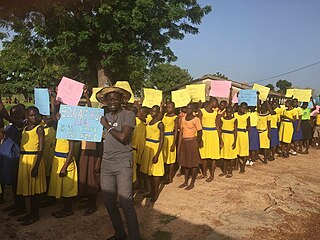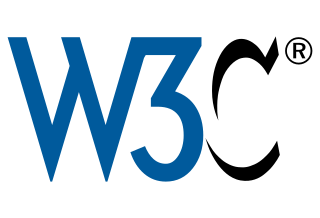The World Wide Web Consortium (W3C)'s Web Accessibility Initiative (WAI) is an effort to improve the accessibility of the World Wide Web for people with disabilities. People with disabilities encounter difficulties when using computers generally, but also on the Web. Since they often require non-standard devices and browsers, making websites more accessible also benefits a wide range of user agents and devices, including mobile devices, which have limited resources. According to a US government study, 71% of website visitors with disabilities will leave a website that is not accessible.

Accessibility is the design of products, devices, services, vehicles, or environments so as to be usable by people with disabilities. The concept of accessible design and practice of accessible developments ensures both "direct access" and "indirect access" meaning compatibility with a person's assistive technology.

Computer accessibility refers to the accessibility of a computer system to all people, regardless of disability type or severity of impairment. The term accessibility is most often used in reference to specialized hardware or software, or a combination of both, designed to enable the use of a computer by a person with a disability or impairment.
The global digital divide describes global disparities, primarily between developed and developing countries, in regards to access to computing and information resources such as the Internet and the opportunities derived from such access.
Universal design is the design of buildings, products or environments to make them accessible to people, regardless of age, disability, or other factors. It emerged as a rights-based, anti-discrimination measure, which seeks to create design for all abilities. Evaluating material and structures that can be utilized by all. It addresses common barriers to participation by creating things that can be used by the maximum number of people possible. “When disabling mechanisms are to be replaced with mechanisms for inclusion, different kinds of knowledge are relevant for different purposes. As a practical strategy for inclusion, Universal Design involves dilemmas and often difficult priorities.” Curb cuts or sidewalk ramps, which are essential for people in wheelchairs but also used by all, are a common example of universal design.
Web accessibility, or eAccessibility, is the inclusive practice of ensuring there are no barriers that prevent interaction with, or access to, websites on the World Wide Web by people with physical disabilities, situational disabilities, and socio-economic restrictions on bandwidth and speed. When sites are correctly designed, developed and edited, more users have equal access to information and functionality.
Inclusive design is a design process in which a product, service, or environment is designed to be usable for as many people as possible, particularly groups who are traditionally excluded from being able to use an interface or navigate an environment. Its focus is on fulfilling as many user needs as possible, not just as many users as possible. Historically, inclusive design has been linked to designing for people with physical disabilities, and accessibility is one of the key outcomes of inclusive design. However, rather than focusing on designing for disabilities, inclusive design is a methodology that considers many aspects of human diversity that could affect a person's ability to use a product, service, or environment, such as ability, language, culture, gender, and age. The Inclusive Design Research Center reframes disability as a mismatch between the needs of a user and the design of a product or system, emphasizing that disability can be experienced by any user. With this framing, it becomes clear that inclusive design is not limited to interfaces or technologies, but may also be applied to the design of policies and infrastructure.

Inclusion in education refers to including all students to equal access to equal opportunities of education and learning, and is distinct from educational equality or educational equity. It arose in the context of special education with an individualized education program or 504 plan, and is built on the notion that it is more effective for students with special needs to have the said mixed experience for them to be more successful in social interactions leading to further success in life. The philosophy behind the implementation of the inclusion model does not prioritize, but still provides for the utilization of special classrooms and special schools for the education of students with disabilities. Inclusive education models are brought into force by educational administrators with the intention of moving away from seclusion models of special education to the fullest extent practical, the idea being that it is to the social benefit of general education students and special education students alike, with the more able students serving as peer models and those less able serving as motivation for general education students to learn empathy.
Computer-supported collaborative learning (CSCL) is a pedagogical approach wherein learning takes place via social interaction using a computer or through the Internet. This kind of learning is characterized by the sharing and construction of knowledge among participants using technology as their primary means of communication or as a common resource. CSCL can be implemented in online and classroom learning environments and can take place synchronously or asynchronously.

The Web Content Accessibility Guidelines (WCAG) are part of a series of web accessibility guidelines published by the Web Accessibility Initiative (WAI) of the World Wide Web Consortium (W3C), the main international standards organization for the Internet. They are a set of recommendations for making Web content more accessible, primarily for people with disabilities—but also for all user agents, including highly limited devices, such as mobile phones. WCAG 2.0 was published in December 2008 and became an ISO standard, ISO/IEC 40500:2012 in October 2012. WCAG 2.2 became a W3C Recommendation on 5 October 2023.

Inclusion, in relation to persons with disabilities, is defined as including individuals with disabilities in everyday activities and ensuring they have access to resources and opportunities in ways that are similar to their non-disabled peers. Disability rights advocates define true inclusion as results-oriented, rather than focused merely on encouragement. To this end, communities, businesses, and other groups and organizations are considered inclusive if people with disabilities do not face barriers to participation and have equal access to opportunities and resources.

The Convention on the Rights of Persons with Disabilities is an international human rights treaty of the United Nations intended to protect the rights and dignity of persons with disabilities. Parties to the convention are required to promote, protect, and ensure the full enjoyment of human rights by persons with disabilities and ensure that persons with disabilities enjoy full equality under the law. The Convention serves as a major catalyst in the global disability rights movement enabling a shift from viewing persons with disabilities as objects of charity, medical treatment and social protection towards viewing them as full and equal members of society, with human rights. The convention was the first U.N. human rights treaty of the twenty-first century.
The Rix Centre is a British charitable research and development centre that was founded in 2004. The Centre, based at the University of East London, explores the uses of new media technology for the benefit of the learning disability community. It has developed multimedia technologies and courses to support those with learning disabilities and their careers.
Knowbility is an American non-governmental organization based in Austin, Texas, working to support the independence and empowerment of people with disabilities by promoting the use and improving the availability of accessible information technology. Its mission is to create an inclusive digital world for people of all abilities. Knowbility's signature program is the Accessibility Internet Rally, a web-building competition that brings together volunteer web designers to create accessible websites for nonprofit organizations and artists that serve communities all over the world.
Design for All in the context of information and communications technology (ICT) is the conscious and systematic effort to proactively apply principles, methods and tools to promote universal design in computer-related technologies, including Internet-based technologies, thus avoiding the need for a posteriori adaptations, or specialised design.
Lisa Seeman is an inventor and an entrepreneur and has been instrumental in creating standards for interoperability and accessibility.
The Inclusive Design Research Centre (IDRC) is a research and development centre at OCAD University in Toronto, Canada. The centre defines inclusive design as that which "considers the full range of human diversity with respect to ability, language, culture, gender, age and other forms of human difference." The research centre is directed by Jutta Treviranus. In 2011 the centre launched a Master of Design in Inclusive Design.

Vicki Hanson FACM FRSE FBCS, is an American computer scientist noted for her research on human-computer interaction and accessibility and for her leadership in broadening participation in computing.
Digital inclusion involves the activities necessary to ensure equitable access to and use of information and communication technologies for participation in social and economic life including for education, social services, health, social and community participation. Digital inclusion includes access to affordable broadband Internet services, Internet-enabled devices, access to digital literacy training, quality technical support, and applications and online content designed to enable and encourage self-sufficiency, participation, and collaboration. Related concepts include digital divide, digital exclusion and digital inequality however digital inclusion focuses more on the strategies, policies and programs required to address the digital divide.
Elizabeth "Liddy" Nevile is an Australian academic and a pioneer in using computers and the World Wide Web for education in Australia. In 1989-1990 she was instrumental in establishing the first program in the world that required all students to have laptop computers, at Methodist Ladies College, Melbourne, Australia.






